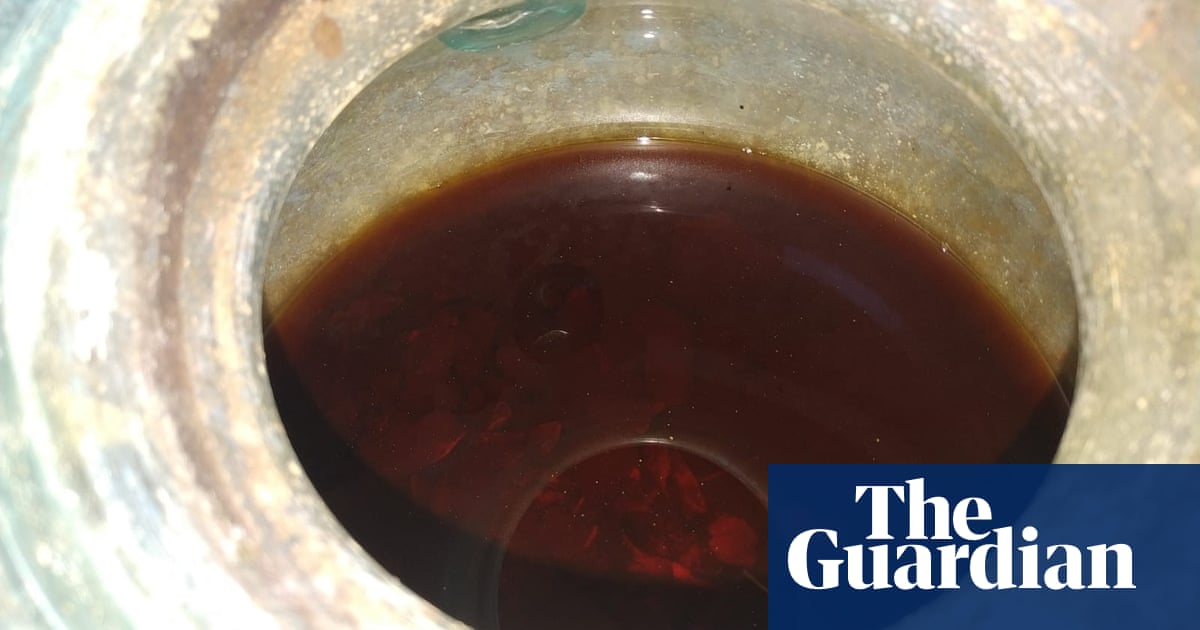Reddish-brown liquid found in untouched 2,000-year-old Roman tomb is a local, sherry-like wine
The oldest wine ever to have been discovered in its original liquid form is reddish-brown and, quite conceivably, full-bodied. Reddish-brown because of the chemical reactions that have taken place in the 2,000 years since the white wine was poured into a funeral urn in southern Spain – and potentially full-bodied because the urn also contained, among other things, the cremated bones of a Roman man.
Analysis by experts at the University of Córdoba has established that the ancient tawny liquid inside the urn – which was found in a rare, untouched Roman tomb that was accidentally discovered in the Andalucían town of Carmona five years ago – is a local, sherry-like wine.
Prior to the discovery, which is reported in the Journal of Archaeological Science: Reports, the oldest wine preserved in a liquid state was the Speyer wine bottle, which was excavated from a Roman tomb near the German city of Speyer in 1867 and dated to about AD 325.
The Spanish urn was recovered in 2019 after a family having some work done on their house in Carmona stumbled across a sunken tomb on their property.
The article doesn’t clearly explain it, but that means this guy’s dying wish was to have his remains put inside a jug of wine? He must have been quite the character in life.
After he was killed at the Battle of Trafalgar, Admiral Horatio Nelson was sent back to England in a barrel of either brandy or rum (accounts differ) to preserve his corpse.
But this dude was cremated like a good Roman.
But this dude was cremated like a good Roman.
Yeah but then asked for his ashes to be decanted into an amphora?
“Did you put the ashes away like I asked you to?”
“Yeah, put them into that urn”
“Dude, that was my wine for tonight. wtf”
He was so mad he went on to invent Franzia

So it could never happen again
that’s the biggest catheter bag I’ve seen so far
You’ve never seen post trans-urethral prostate resection continuous bladder irrigation before.
Bonum vinum laetificat cor hominis
“Good wine gladdens a person’s heart.”
All my hominis are bonum vinum.
https://en.wikipedia.org/wiki/Sucking_the_monkey#Tapping_the_Admiral
That’s how he started his journey, at least

maybe he had a Keith Richards family member who wanted to get drunk on their remains.
It’s pretty clear imo, the seared bones were sealed in the urn full of wine and an additional unworn decorated golden ring. The researchers even talk about reluctance to try it, because while it is perfectly safe judging by the microbiological analysis: it’s had contact with the bones and is quite murky.
I am a historian whose specialty is too recent to deal with anything like that (20th century), but also have a friend who, to be generic here, deals with a handful of a few centuries back. She found a baggie of a drug mistakenly stored with a letter in an archive (think 18th century) and on a whim, dipped their pinky into the powder and tried it. They regret that decision, but also, nothing happened:)
EDIT: Historians can be boring, but not always that tame
All of which raises a rather indelicate question. Was none of them tempted – even fleetingly – to sample this remarkable, historic wine?
Ruiz Arrebola admits he half-jokingly suggested to the lead archaeologist, Juan Manuel Román, that they have “a tiny little glass” to celebrate the discovery.
What’s with this half-jokingly shit? Give me the glass, I’ll drink it.
I bet they were remembering the story of the Egyptian Archaeologists who discovered a jar of honey and they all had a taste. Then they found a fetus in the jar.
Oh you know what- Snopes says it didn’t happen! It’s maybe just an urban legend.
Pussies. That just adds flavor.
You’d die of some horrible malady surely
I’ll take one for the team, and don’t call me Shirley.
They called you ma’lady Shirley
“It’s not in the least bit toxic – we’ve done the microbiological analysis,” he said.
They’d be just fine.
“But I’d have qualms about that because this wine has spent 2,000 years in contact with the cremated body of a dead Roman. The liquid is a bit murky because of the bone remains. But I guess you could filter it and try it. I’d rather someone else tried it first, though.”
You might wanna rethink that, but without knowing you, maybe not.Nope, you said you’re cool with it, so bottoms up.
Didn’t Romans put lead in their wine to make it sweeter?
Lead acetate, yes, a common practice.
Yeah, should’ve put them in the pipes like modern people do.
Fun fact: the Romans used lead for water pipes too. They knew it had detrimental health effects, but the water caused a mineral buildup in the pipes that protected the water from lead contamination.
How’d they fortify it? I thought they didn’t do distillation until at least the 10th century and it was too warm to do fractional freezing.
You got downvoted but it’s a valid question. They don’t state that the wine was fortified, however, but the comparison to sherry does suggest that.
In my reading is only compared to sherry because it’s from the same region.
Oh I had downvoted myself. I do that that for fun sometimes. It often results in a lot more downvotes and is funny.
Aha I see.
Downvoted :p
Somebody will take a sip.
This is the best summary I could come up with:
Analysis by experts at the University of Córdoba has established that the ancient tawny liquid inside the urn – which was found in a rare, untouched Roman tomb that was accidentally discovered in the Andalucían town of Carmona five years ago – is a local, sherry-like wine.
“It’s a sunken tomb that was excavated from the rock, which allowed it to remain standing for 2,000 years,” said José Rafael Ruiz Arrebola, an organic chemist at the University of Córdoba who led the analysis of the wine.
Although the tomb made headlines last year when researchers announced that they had found a crystal bottle in one of the urns that contained a 2,000-year-old patchouli-scented Roman perfume, it had not given up all its secrets.
Once Ruiz Arrebola and his team had established that the five or so litres of reddish liquid in the glass flask inside the urn hadn’t come from condensation or flooding, they set about analysing it.
The chemist and his team hope the techniques they refined and built upon during their investigations will help other researchers who study ancient food and wine.
Ruiz Arrebola admits he half-jokingly suggested to the lead archaeologist, Juan Manuel Román, that they have “a tiny little glass” to celebrate the discovery.
The original article contains 823 words, the summary contains 208 words. Saved 75%. I’m a bot and I’m open source!
Sounds rank af
I wonder how it was sealed. Is glazed ceramic + wax that airtight? The article (nor many very similar ones from other sites) doesn’t give specifics.









